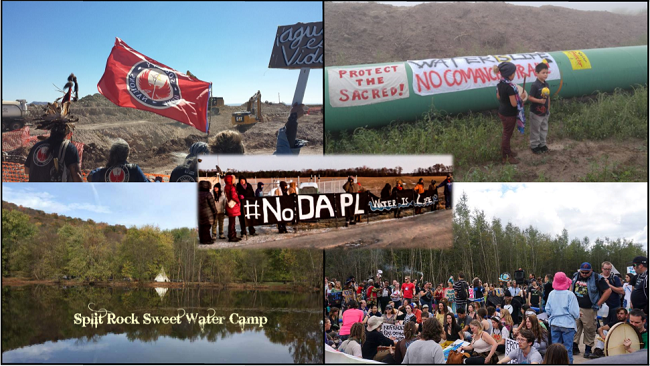Indigenous-Led Pipeline Resistance Camps Spread Across the USA
Direct opposition to fossil fuel extraction projects continues to spread throughout the USA. Resistance camps mirroring the #NoDAPL encampments opposing the Dakota Access Pipeline (DAPL) have sprung up to resist the Sabal Trail, Trans-Pecos, Comanche, AIM, and Pilgrim Pipelines.
Water protectors are concerned about the threats to the environment posed by the fracking process and the boring that occurs when pipelines are constructed underneath waterways.
TRANS-PECOS PIPELINE – TEXAS
Like DAPL, the Trans-Pecos Pipeline (TPPL) project in West Texas is being built by a coalition led by Energy Transfer Partners (ETP). Trans-Pecos is a 148 mile, 42 inch diameter, natural gas “intrastate pipeline designed to transport 1.4 billion cubic feet per day of clean-burning natural gas as part of an agreement with Comisión Federal de Electricidad, Mexico’s federal electricity commission.”
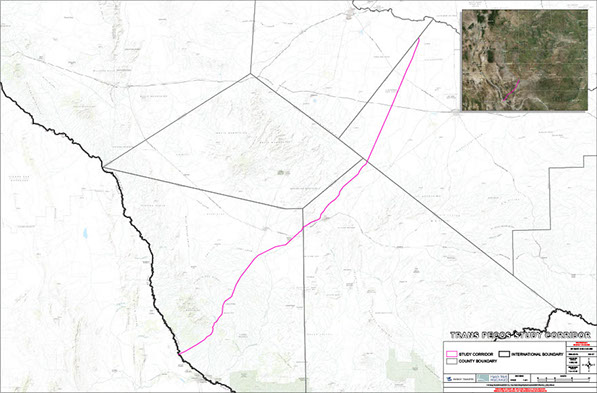
Proponents of the pipeline say that bringing Mexico natural gas will help with the air pollution in Texas as Mexico will be able to close its coal power plants. Some also hope that the natural gas pipeline will ensure that their towns will get natural gas, as they use propane for heat.
In the Environment tab on TransPecosPipelineFacts.com, a statement made by Energy Transfer Partners, among headers of Dark Skies and Restoration, reads that:
“During the initial conception stage of the pipeline and its proposed route, we selected a route that avoided and minimized the crossing of sensitive environmental resources as our base routing guideline. This, coupled with avoidance of residences, defines the route initially and then the entire route is field verified by civil, environmental and cultural survey studies that further identify sensitive areas for the project to avoid.“
Since 2015, dozens of archaeologists, landowners, ranchers, anarchists, and other concerned citizens have organized groups like the Big Bend Conservation Alliance, which is now called Big Bend Defense Coalition, to oppose the Trans-Pecos Pipeline. Issues from this pipeline have even had conservative ranchers asking the federal government to intervene to prevent construction.
TPPL is paid for by Mexico, and Mexico decided the pipeline’s route. Energy Transfer Partners is listed as a “common carrier” in Texas, so they have “a great deal of leeway to override individuals’ property rights“. This gives ETP the ability to use eminent domain and/or cheaply buy-off citizen’s land to construct the pipeline.
In direct opposition to TPPL, direct actions, prayer, and ceremonies took place in Texas in late November. Just before the new 2017 calendar year, on December 30th, Two Rivers Camp in West Texas was formed.
Water protectors from the Society of Native Nations, and the Big Bend Defense Coalition founded the Indigenous-led Two Rivers Camp, or La Junta de los Rios, in Presidio County, Texas, to prevent the completion of the Trans-Pecos Pipeline. A statement released by Two Rivers Camp explain their decision to begin a direct action campaign:
“The Trans Pecos Pipeline (TPPL) is owned by Kelcy Warren, billionaire and CEO of Energy Transfer Partners, the same company that owns the Dakota Access Pipeline in North Dakota. The TPPL is a fracked gas pipeline that is being built through west Texas. It will go under The Rio Grande River into Mexico where the gas will be exported to various foreign countries. One hundred and forty three (143) miles of this pipeline is considered “intra-state,” which means it requires NO environmental, archaeological, socioeconomic, safety, routing or other studies or impact assessments have to be done or taken into consideration.
The TPPL will:
1) Go through the Chihuahuan Desert, which is one of the three most biologically diverse arid regions in the world.
2) Will destroy the delicate ecology on both sides of the border.
3) Go under the Rio Grande. In the event of a leak or an explosion, the methane from the gas could infiltrate the water aquifer that sits just 50 feet below the Rio Grande.
4) IF completed, FRACKING will begin to take place and this will bring on a whole new set of water contamination issues to a water source that is already scarce to the area.
5) The pressure testing of the pipeline ALONE is also going to use millions of gallons of water.
Energy Transfer Partners (company also behind DAPL) has forcibly taken land from 34 local landowners in the name of eminent domain, a legal process that should only be used to benefit the public. NO ONE in the United States will benefit from this pipeline but Kelcy Warren and his billionaire cronies.“
On January 7th, a week after the camp was founded, two water protectors were arrested for locking down to construction excavators in a direct action that stopped construction for the day. In a video from the Jan. 7th action Two Rivers Camp organizer Frankie Orona states:
“People are coming in from other states, people are coming down from North Dakota, the momentum’s growing and its growing here in Texas and that’s what we need. All the fracking that’s going to be happening here that’s gonna be contaminating not just the water, the land, the air, but sacred sites and land that’s owned by people who have lived here for generations and they’re feeling like they’re getting bullied.” – Frankie Orona
Another action involving lockdowns to construction equipment occurred during Saturday, January 15th. Two people who called themselves Earth Protectors, were arrested, one of whom was charged with felony criminal mischief as well as felony interference with a state machine.
COMANCHE TRAIL – TEXAS
Comanche Trail Pipeline is another Energy Transfer Partners pipeline project that, like the TPPL, originates from the “Waha Hub outside Fort Stockton, Texas in northern Pecos County”, and like the TPPL, goes to the Mexican border attaching to another pipeline with the sole purpose of bringing natural gas to Mexico. Comanche Trail is a 195 mile natural gas pipeline slated for a January 2017 completion date.
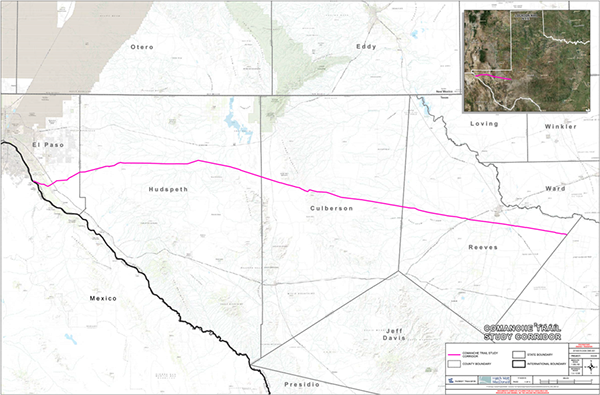
This pipeline had recently been halted by the federal government with a temporary restraining order in late 2016 due to lawsuits, border issues, and construction damages such as collapsing creeks and canals.
A couple of weeks ago, in late December, the official go-ahead to resume the project was granted, and a new round of direct opposition to, and direct actions against, the Comanche Trail Pipeline’s construction completion have begun.
In San Eli, Texas, on Wednesday, January 12th, 2017, two water protectors targeted Pumpco construction equipment, owned by ETP’s CEO Kelcy Warren, in attempts to stop work. One person locked down to the backhoe and another locked themselves underneath it.
With the newly created US-Mexico Energy Business Council (May 2016), pipeline projects such as the Trans-Pecos and the Comanche Trail will continue to grow in number, often endowed with an ability to supersede local laws and regulations.
SABAL TRAIL TRANSMISSION – FLORIDA
The Sabal Trail Transmission is a three-state, $3 billion natural gas pipeline project that is due to be completed by June 2017. Partners in this joint ‘Sabal Trail’ project which starts in Alabama, goes through Georgia, and ends in Florida, are Spectra Energy Corp., with 59.5% ownership, NextEra Energy, Inc. with 33%, and Duke Energy with 7.5%.
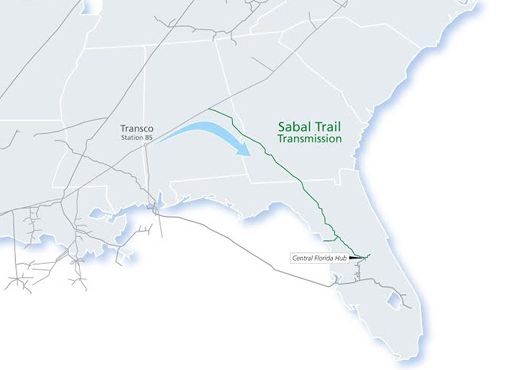
Spectra Energy, the main owner of the Sabal Trail Pipeline, has a history of pipeline accidents, with a single pipeline (the Texas Eastern Transmission pipeline) causing over twelve million dollars in property damage in the last decade.
On Sabal Trail’s website, it’s written that the “underground pipeline will bring additional affordable, clean natural gas supplies to Florida“. Many opponents believe that it presents too many environmental risks. Some of those opponents, in late 2016, initiated the Springs not Pipelines action camp in an attempt to stop the Sabal Trial Pipeline.
In a report-back from the direct action camp, Panagioti Tsolkas states:
“There is a bounty of reasons to oppose this project, from the regional threats our waterways and wild lands to the global impacts of climate change. For a few examples, the project is slated to impact 4,370 acres of forests, 1,958 wetland systems and 699 waterbodies; it will emit greenhouse gas and toxic pollutants through its compressor stations, not to mention the impacts from power plants that will burn the fuel for electricity and the Liquefied Natural Gas (LNG) terminals that will process and store the fuel. Add to that the utter disregard for low-income/minority “environmental justice communities”—the Environmental Impacts Statement (EIS) acknowledged that 83.7% of the Project would cross or be within one mile of environmental justice populations, including 135 environmental justice communities. That is to say nothing of ongoing eminent domain proceedings and the potential impacts of leaks and combustion.” – Panagioti Tsolkas
Fourteen people were arrested in November for blocking equipment needed to continue construction at the site of the Santa Fe River. Resistance has continued through the winter and is growing. On January 12th, there was a die-in at the Florida State Capitol building in Tallahassee protesting the Sabal Trail Pipeline.
A January 14 press release by Stop Sabal Trail states that four camps, dubbed the “heartland camps” have now been created. A call-out for mass civil disobedience to stop the Suwannee River crossing construction took place on Saturday, January 14th, as hundreds of people marched and came together in a festive gathering in attempts to shut down the construction areas near Suwannee River.
With claims of the Sabal Trail being built through indigenous burial grounds and the continued concerns about the pipeline’s safety, this struggle will likely continue to become a focal point in the Southeast region of the United States of America.
DAKOTA ACCESS PIPELINE – ILLINOIS
The historic autonomous #NoDAPL encampments continue near Cannonball, North Dakota, on 1851 treaty land, to preserve the Missouri River and prevent pipeline construction. As they move through the harsh winter conditions into mid-January of 2017, construction continues away from Lake Oahe, where the Army’s Dec. 4th denial of the Lake Oahe easement has prevented full boring under the Missouri River.
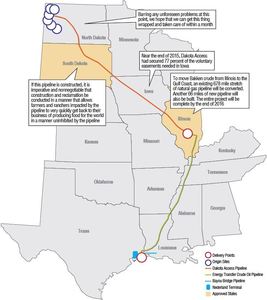
Two states away, in southern Illinois, a prayer action on December 18th, in which two people were arrested, brought to light that DAPL construction has yet to be fully completed.
A press release by Illinois water protectors, states that they have observed several active DAPL construction sites across southern Illinois. They stated that after noticing ongoing construction,
“Water protectors from different communities across the state of Illinois, led by Lakota activists, met for a rally in Effingham, IL and then caravanned to conduct a water ceremony at the Kaskaskia River crossing.” – Illinois water protectors
In their statement from the Dec. 18th action, they detail how they were “met with an authoritarian presence; dozens of police and private unmarked security vehicles that followed our caravan.” Both of the two arrested water protectors have since had their charges dropped.
In response to the police endeavors, Laura, from the Illinois Water Protectors spoke to Unicorn Riot about their upcoming call-in action, dated for January 18th, the day of the original court date for the two arrests in December:
“We demand accountability of our government officials to do their jobs. We are telling them to stop serving the interests of filling their own campaign contribution funds. Stop forcing the police to work against the communities they are supposed to protect. Finally, show some overdue respect to the people of this land who are entitled to the freedoms of speech, religion, and assembly, as well as having clean air, water, and earth in every community, and not just some communities. We are not going to stand for politicians to sit idle or to actively assist in the mass poisoning of human beings.” – Laura Doligosa
For further context on what is propelling these water protectors’ actions in Illinois, Indigenous activist Janie Pochel told Unicorn Riot:
“Construction of DAPL in Illinois is not complete, and once again we see that police continue to work on behalf of ETCO, using intimidation and repression against water protectors. We will continue to fight them. There are many ways to fight: construction is not complete, permits can still be challenged and rescinded, the divestment campaign is still mounting, and we have found that DAPL has disturbed several Indigenous burial sites along the pipeline route. We call on communities across Illinois to commit to stopping this and all other pipelines, and to upholding the sovereignty and self-determination of native peoples across Turtle Island.
No more repression against native peoples and water protectors!
I have this radical idea that all this land is Native land. We have the right to pray on our lands, and water, just like we’ve done for thousands of years, but we have no freedom to practice our right.” – Janie Pochel
Recent changes in the political scene bringing a pipeline-friendly Trump administration make it likely that things will ‘heat up’ in the continuing resistance against the Dakota Access Pipeline.
PILGRIM PIPELINE / AIM PIPELINE EXPANSION – NEW JERSEY
Pilgrim Pipeline, in the Northeast region of the USA, is being constructed by Pilgrim Holdings, LLC. to move oil through the region. “The 178-mile parallel underground pipelines will run between supply and distribution terminals in Albany and Linden, New Jersey.”
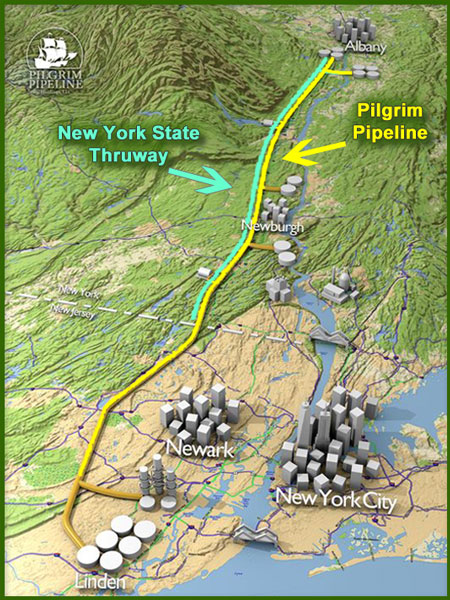
The Ramapough Lenape Nation, a tribe recognized by the states of New Jersey and New York, but not the federal government, are still trying to clean up from years of toxic contamination of its lands by a Ford plant decades ago. Now they’re dealing with the new Pilgrim Pipeline and the expansion of the AIM pipeline.
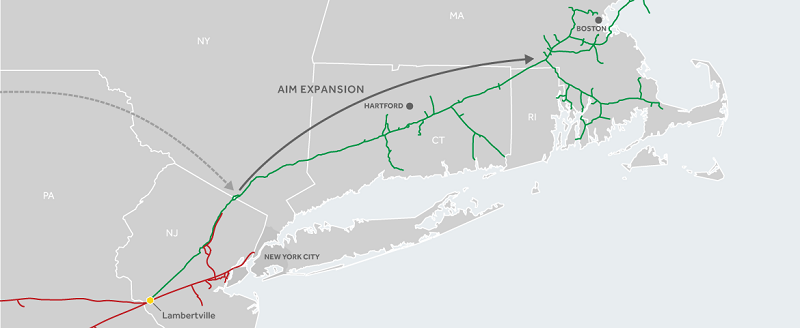
In efforts to protect their land from AIM and Pilgrim, a month or two ago, the Ramapough erected teepees and tents on their land and have had prayer gatherings and ceremonies at Split Rock Sweet Water Camp.
Mahwah, New Jersey officials have attempted to challenge the tribes erecting of the teepees saying that they need zoning permits and on December 29th, the Township of Mahwah “issued a Notice and Order of Penalty and Notice of Violation and Order to Terminate to the Ramapough Tribe regarding the Split Rock Sweet Water Camp. The Town of Mahwah is ordering the Ramapough Tribe to pay a total of $2,000 per week in penalties related to Split Rock Sweet Water. Other alleged violations carry a fine of up to $1,500 and 90 days in jail.“
This resistance against these pipelines has been ongoing, as The ‘Montrose 9’, arrested for blockading the Spectra’s AIM pipeline in November of 2015, were recently (Friday, January 6th) sentenced to community service after being convicted of disorderly conduct.
This new map below, by acclaimed Indigenous mapmaker Aaron Carapella, entitled “Proposed Pipelines in Tribal Homelands“, shows all of the proposed and partially built pipelines going through tribal lands in North America and Mexico.

Follow our media on Twitter, Facebook, and our website for more information surrounding ongoing social and environmental struggles. To see the archives of our previous #NoDAPL coverage, click here and view our previous round-up article about eco-defense actions from November 2016: Land Defense & Water Protection Actions Ripple Across Turtle Island.
To support our volunteer-operated, horizontally-organized, non-profit media collective please consider a tax-deductible donation:
Cover Image photo credits: Two Rivers Camp (Top left – Trans-Pecos & top right – Comanche Trail), Split Rock Sweet Water Camp (Bottom left – AIM/Pilgrim), Stop Sabal Trail (Bottom right – Sabal Trail), #NoDAPL (Middle – Illinois Water Protectors)
